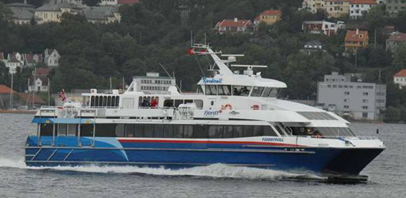Most of the classification societies have construction criteria for high-speed craft. Studies are being embarked on to perk up the international standards related to high-speed vessel. The updated versions of high-speed crafts have robust engineering and technical sophistication. Generally, the hulls are designed by using light weight materials. Weight has an unfavourable outcome on functionality and speed. Every kg of weight saved in the setup, machinery and structure adds to the performance and also the weight available for fuel and payload.
Stress analysis of hull during the design process
The high speed vessels/ catamarans are being built accordingly to meet HSC (high speed code). During the design process, the stress analysis of the hull is looked at very carefully. The main objective is to make the hull as light weight and still as possible. To achieve this, majority of the hulls are constructed using marine grade composites and/or 5000 series aluminium. If steel is used, it has to be of very high quality. Composite construction is the lightest and most costly construction procedure by making use of carbon fibre or high-tech materials. The cost is high due to expensive raw materials, and cost associated with tooling, moulds, curing processes and lamination. Normally, composite hull are present on vessels of length 30 meters or less.
Directional steadiness and manoeuvrability
As compared to conventional vessels, most of the multi-hull designs have minimal speed loss in rough waves due to decreased pitching motion. Manoeuvrability and directional steadiness at low and high speeds are evaluated to be fruitful because of the hulls separation and the propulsion units’ outboard location. Catamarans/fast ferries will have to adjust their speed according to the actual wave height. Generally, multi-hulls have less capacity to carry cargo than mono-hulls, per displacement ton. Because of high centre of gravity, which means low metacentric height, the distribution of weight becomes more sensitive.
Reduced rolling motions to enhance passenger comfort
Reduced rolling or pitching motions improves passenger comfort. High-speed ferries for sale have loads of specific equipment to enhance passenger comfort like stabilization units. The passenger accommodation space often have aviation seating feature.
In most of the situations, the vessels are designed to function and operate on particular geographic location and services. The proposed usage is examined related to route, speed, service, passenger and cargo capacity, operational matters, passenger comfort and environmental factors. The special design parameters of a vessel can be modified for use as per particular service. So, fast ferries for sale can be customized as per the concerning usage.
Special focus must be given to the construction and design of high-speed vessels. Design, construction and manufacturing from reliable firms and yards are preferred. The commonly used main engines are high-speed and medium diesels. Classification status from a well-known Society is important. Normally, all catamarans are being built to drawings approved by highly recognized class society. The capability of a ship to keep floating after an accident should be verified, giving special attention to reserve buoyancy and hull compartmentalization. If the vessel is a used one, its earlier service history should be asked for. Paying attention to recurring troubles or downtime would help in operational functionality. There are many types of designs that have been serving the commercial shipping industry over a period of time.


